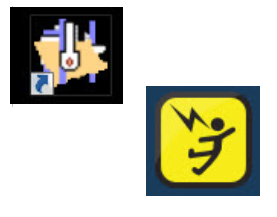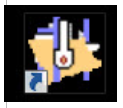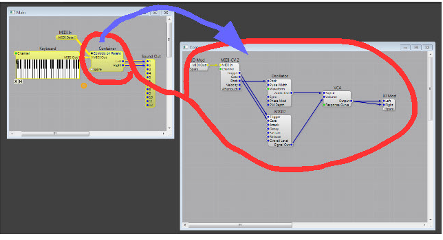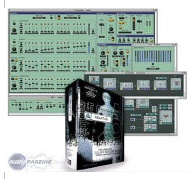In the World of Grains – Part 5

In the World of Grains – Part 5
(contains embedded video) If you want to support my work, please make use of the "PayPal" button - thank you very much indeed!
… and some more comnputer languages to be used to code granular synthesis, granular sound processing and granular sound design:
OpenMusic
To say it at once: OpenMusic is not mainly meant to manipulate sound. It is not a dedicated sound processing programming environment. Its main purpose is coding compositions, working with notes and notations and manipulating scores.

It´s an excellent tool for investigating musical interrelations, for experimenting with harmonies, melodies, tonal systems and rhythms – and for teaching all of this.
So, why do I mention OpenMusic here in this book at all?
Well, there are add-ons called “libraries”, which can be loaded into OpenMusic, some of which do deal with sound processing, even with granular sound processing (e.g. OMChroma).
Then OpenMusic supports the SDIF file transfer standard, so that we can transfer data to other software tools, which support this standard too.
Further we can switch from the graphical user interface directly to the language LISP (where we can basically code whatever we want – soundwise or not).
Not to forget, that there is a data bridge to CSound, what is basically the ability of OpenMusic to read CSound files.
The documentation is not bad, but by far not as good as the one of e.g. MAX or PureData, and there are only a few sources of further information and help about OpenMusic.
One which is – of course – the IRCAM website and the OpenMusic forum there, which is quite “lively” (about 1 or 2 posts a week). And there is a good and helpful mini series of video tutorials on YouTube, which – unfortunately – doesn´t go as far as to sound processing, but is limited to (mere) score manipulations. But it helps getting up and running. (see the “References and Sources” chapter).
The so far latest version (now in May 2020) is version 6.16 from 13/01/2020.

SynthEdit
With SynthEdit we have finally left the fielt of mere computer languages and have entered the realm of higher level programming environments. Both – SynthEdit and NI Reactor (see next paragraph) are something between a programming tool and an application, with SynthEdit being more a programming tool. and Reactor being both: tool and ready application.
SynthEdit´s main concern is offering mighty tools for building up software instruments and sound effects leaning to more classical style sounds and synthesizers, like ARP, Moog, Oberheim, Roland and others of their era.
Yes, it is a bit cumbersome to go into granular sound processing with SynthEdit – cumbersome, but not impossible. There are some simple sound machines and effects using granular techniques made with SynthEdit on the market – some of which are freeware (e.g. “Granulator” by Dave Haupts, or “Granola” by KlangLabs).
SynthEdit enables the users to make their own VSTs – in its 64bit version even VST3s and AUs.

There is an active Community around SynthEdit, there are a lot of free online resources (Scripts, PDF, YouTube videos and others, and there are some really good free softsynths made with SynthEdit. Right now (11/06/2020) the SynthEdit community is building/collecting a community repository for products made with SynthEdit.
SynthEdit comes with a comprehensive online manual, but I recommend downloading the ebook (PDF file) by Fortune, Schoffhauzer and Haupt, which I mention in the Resources Chapter. It offers a far better approach to SynthEdit for beginners.
Coding in SynthEdith is done by patching and linking functional blocks like e.g. oscillators, filters, VCA. But there are also lower level functions (math and logic functions etc.).
Functions can be combined to so called “containers”, which then can be handled as higher level functional blocks.
Everything is quite intuitive in SynthEdit.
The latest version (in Mai 2020) is version 1.4.
Please watch the short video to get a better impression of what SynthEdit is, and how it “feels” working with it:

Reaktor
There´s a quite high probability, that you´ve already heard about Native Instruments´ Reaktor, isn´t it?
Well, Reaktor would fit well in the the chapter about VSTs, AUs, and other “complete” applications too, because it´s kind of all of these: an application, an environment for developing sound processing software, and a computer language with a graphical user interface.
Reaktor comes with 7 user manuals of all in all 1,260 pages – and you´d better read at least half of them, to get good at using this software – even if it needs a lot less (let´s say 80 pages and some of the numerous YouTube tutorials) to just getting started.
But let me proceed systematically. You can use Reaktor on three different levels of depth.
Ensembles and their contained instruments build the top level, let´s say the surface of Reaktor. Here we find ready made musical instruments to play. This level isn´t a matter of this chapter.
If we change to EDIT mode we are on the next level, a bit deeper in sound processing, called “Primary”. Here we meet the individual functional units, that make an instrument. We can built out own instruments here, by adding and combining these functional blocks. The Primary level looks a lot like the aforementioned SynthEdit.
Level three lets us look at the core of digital sound processing – well, even its name is “Core”. Here we are looking straight at the guts of every digital sound processor. There isn´t anything concerning sound, that you cannot achieve on that level, everything is possible – and everything is extremely cumbersome (but fun, and pure amazement).
Compared with e.g. MAX or PureData, their functionality covers Reaktor´s Primary level as well as parts of the Core level. And there are those Reaktor “Blocks”.
Following my systematic, I´d say, that “Blocks” are Primary-level units coming along and looking like top-level instruments, meant to mimic the modules of a classic modular synthesizer. Here Reaktor is competing with software like Softube´s “Modular”, Cherry Audio´s “Voltage Modular”, or VCV Rack.
There are a couple of ready made instruments, which deal with granular sound processing made in Reaktor. They are going to be introduced and discussed in later chapters (see “VSTs, AUs and other Applications”).
As developers of granular sound machines of our own, we would focus (a bit) on level two (“Primary”), and (a lot) on level three (“Core”), which means: 1,260 pages – and not only half of them!
There are so many good tutorial videos about Reaktor out there for beginners, and there´s no need for me adding an additional one. Let me refer to the Resources chapter in this book. The link to the Reaktor Community there leads you to a a rich selection of excellent videos. Just take the first one or two about each of the above mentioned levels – and you will already be going down the rabbit hole ….. (there might well be an extra book about building granular VSTs, AUs and applications with Reaktor though).
… and even more
There are more computer languages and programming environments, which are more or less capable and more or less suitable for granular sound processing out there, and I´ll possibly write about them in a later edition or in one of the later parts of this series of ebooks about the soundworld of grains. Here and now I´ve mentioned those, which I think are the most important at the moment.
(And there are companies out there, which seem to be arrogance driven to such a degree, that they don´t answer at all, or answer my comprehensive letter concerning a rather patchy documentation of their product by simply sending me 1 single sentence - after some months. Their products won´t be mentioned either here nor in my books.)
to be continued
to part 1: ("A Short History of Granular Synthesis - Part 1"):https://www.dev.rofilm-media.net/node/340
to part 2: ("A Short History of Granular Synthesis - Part 2"): https://www.dev.rofilm-media.net/node/342
to part 3: ("A Short History of Granular Synthesis - Part 3"): https://www.dev.rofilm-media.net/node/346
to part 4: ("A Short History of Granular Synthesis - Part 4"): https://www.dev.rofilm-media.net/node/356
to part 5 ("In the World of Grains - Part 1"): https://www.dev.rofilm-media.net/node/364
to part 6 ("In the World of Grains - Part 2"): https://www.dev.rofilm-media.net/node/373
to part 7 (“In the World of Grains – Part 3”): https://www.dev.rofilm-media.net/node/378
to part 8: (“In the World of Grains – Part 4”): https://www.dev.rofilm-media.net/node/385
to "In the World of Grains" part 6: https://www.dev.rofilm-media.net/node/398
to "In the World of Grains" part 7: https://www.dev.rofilm-media.net/node/407
to "In the World of Grains" part 8: https://www.dev.rofilm-media.net/node/414
to "in the World of Grains" part 9: https://www.dev.rofilm-media.net/node/421
to "in the World of Grains" part 9: https://www.dev.rofilm-media.net/node/421

Add new comment